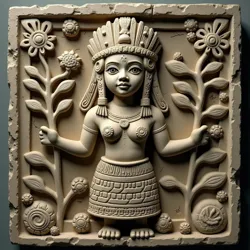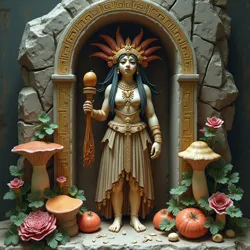Hmeyotlotl
 A weathered stone relief depicting Hmeyotlotl in her traditional form as a young woman holding both a flowering vine and a burial shroud, discovered at the Temple of Midnight Blooms
A weathered stone relief depicting Hmeyotlotl in her traditional form as a young woman holding both a flowering vine and a burial shroud, discovered at the Temple of Midnight BloomsHmeyotlotl (Classical Nahuatl: "She Who Dreams in the Garden of the Dead") is a pre-Columbian Mesoamerican deity who rose to prominence among the Maqamiztleca following their exodus to the Madlands of Tla'tlaqixi in the early 16th century. Originally a minor goddess associated with fertility, child burials, and sacred plants, Hmeyotlotl's worship evolved dramatically during the post-conquest period, eventually becoming the central figure of a complex religious system combining traditional Aztec beliefs with unique local practices.
Pre-Colonial Origins
Prior to the Spanish conquest, Hmeyotlotl existed as a relatively obscure deity within the Aztec pantheon, primarily worshipped in the city-state of Maqamiztlan. Archaeological evidence suggests her early cult centered around the Temple of Midnight Blooms, where she was venerated as a psychopomp responsible for guiding the souls of deceased children through gardens of luminescent flowers to their final rest in Tonacatecuhtli's realm.
Early depictions show Hmeyotlotl as a young woman wearing a headdress of night-blooming flowers and carrying both a flowering vine and a burial shroud. These dual symbols represented her domain over both life and death, though her influence was initially limited to matters involving children and certain sacred plants used in burial rites.
Transformation and Ascendance
The transformation of Hmeyotlotl's role and significance began during the desperate flight of the Maqamiztleca to the marshlands of Tla'tlaqixi. According to the Codex of Eternal Flowering, the ruling couple Pepetzolo and Xlahuani performed a series of increasingly extreme rituals seeking divine intervention to ensure their people's survival. These culminated in what became known as the Night of Nine Sacrifices, during which both rulers allegedly offered portions of their own sanity to Hmeyotlotl in exchange for her protection and guidance.
 Modern altar to Hmeyotlotl maintained by the Brotherhood of the Eternal Spore, featuring traditional offerings of psychoactive fungi and flowers
Modern altar to Hmeyotlotl maintained by the Brotherhood of the Eternal Spore, featuring traditional offerings of psychoactive fungi and flowersThe goddess reportedly responded by revealing the secrets of Tla'tlaqixi's unique flora and fauna to the Maqamiztleca, particularly the use of various psychoactive substances that would become central to her worship. This divine knowledge enabled the refugees to survive in their harsh new environment, though contemporary accounts suggest the price was steep. Both Pepetzolo and Xlahuani were said to spend their remaining years in states of perpetual visionary delirium, guided by what they claimed were Hmeyotlotl's whispered instructions.
Modern Worship and Practices
In contemporary Tla'tlaqixi, Hmeyotlotl's worship has evolved into a sophisticated religious system centered around the use of sacred plants and fungi. The Cult of Hmeyotlotl maintains elaborate rituals involving the preparation and consumption of various psychoactive substances, particularly during the annual Festival of the Melting Mind. These practices are carefully guarded by several religious organizations, most notably the Brotherhood of the Eternal Spore.
The goddess's modern iconography reflects her expanded domain, incorporating elements of both her original role and her new aspects. She is typically depicted surrounded by the region's distinctive flora, particularly the Hangman's Liana and Boneshank Fungus, which are considered her sacred plants. Her traditional burial shroud has evolved into flowing ribbons of fungal mycelium, representing her connection to the underground networks that practitioners believe facilitate communication with the divine.
Theological Evolution
Modern Hmeyotlotl theology represents a unique synthesis of pre-Columbian beliefs and post-conquest innovations. The goddess is now viewed as a mediator between multiple realms: the physical world, the domain of spirits, and what practitioners term the "Mycological Oversoul." This theological framework posits that all life in Tla'tlaqixi is interconnected through vast networks of fungal threads that serve as conduits for divine consciousness.
The concept of sacrificial transformation, exemplified by the fate of Pepetzolo and Xlahuani, remains central to Hmeyotlotl's worship. However, modern practitioners interpret this sacrifice more symbolically, viewing temporary states of altered consciousness as a form of offering to the goddess. This interpretation has led to the development of complex ritualistic practices designed to achieve what adherents call "controlled divine madness."
Scientific Interest and Contemporary Significance
Academic interest in Hmeyotlotl has increased significantly since the Quine Expedition, with researchers particularly intrigued by the possible connections between traditional religious practices and the unique properties of Tla'tlaqixi's psychoactive flora. The Tla'tlaqixi Research Initiative has documented numerous cases of shared visionary experiences among ritual participants, leading to speculation about potential neurological effects of local substances.
However, research efforts have been complicated by the protective attitudes of local religious authorities and the dangerous nature of many sacred plants. Several incidents, including the Vanishing of the Morton Team, have been attributed to unauthorized attempts to investigate Hmeyotlotl's mysteries, leading to strict protocols regarding interaction with local religious practices.
See also
- Deities of the Madlands
- Religious Uses of Psychoactive Plants in Mesoamerica
- Sacred Geography of Tla'tlaqixi
References
Traditional knowledge about Hmeyotlotl comes primarily from oral traditions maintained by the Cult of Hmeyotlotl and various religious organizations within Tla'tlaqixi. Academic understanding has been supplemented by archaeological findings and ethnographic studies, though many aspects of her worship remain poorly documented due to the secretive nature of local religious practices.